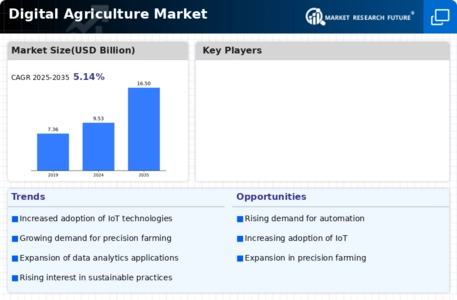Growing demand for high production and better crop quality drives market growth.
On the other hand, individuals need more technical knowledge to maintain market growth. AI and algorithms for learning are quickly becoming commonplace in farming goods and in-field practices. Cognitive computing has gained acceptance in the industry because it helps people learn, analyze, and adapt to new circumstances while increasing efficiency. Chatbots and other conversational systems, for example, assist farmers in keeping up with current technology.
Additionally, the increasing need for high productivity and enhanced crop health, a growing lack of farm labor, and increased worries about food security and nutrition are a few reasons driving the expansion of the digital agricultural business. Yet, the complicated system of connectivity, high prices of technology, and a lack of technical expertise for optimal technology utilization are impeding market growth.
Nonetheless, the increasing potential for progressing multiple SDGs, the ability to boost efficiency and generate novel markets, and the growing adoption of modern technology in the farming industry present growth opportunities for market vendors. The growth of the digital era moves the world towards new types of labor. Agriculture and agriculture sectors benefit from technological advancements. The use of cell phones for digital agriculture has expedited this change. Increasing Internet and digital connection has the potential to be useful in underdeveloped countries.
COVID-19 harmed the farming industry due to the national lockdown, limitations on travel, and the suspension of imports and exports due to limited mobility for migrants and rural laborers during the pandemic, leading to a shortage of labor that hindered crop production around the world. Due to constrained shipping and unfavorable transaction consequences, the COVID-19 epidemic has reduced agricultural equipment sales. The interrupted supply chain impacted the farm equipment distribution channel and impeded smart farming gear purchases. The COVID-19 epidemic, on the other hand, drove the sector towards digitization.
During the pandemic, the use of technology, including farm administration systems, applications for smartphones, and wireless gadgets, gained popularity. According to the 2021 Finistere Ventures' 2020 Agrifood Tech Funding Review, crop protection and input management protected the agricultural biotech industry.
For instance, according to a new UN estimate, the globe's population of 7.6 billion will increase to 8.6 bn in 2030, 9.8 bn in 2050, and 11.2 bn in 2100. Thus, demand for Digital Agriculture is anticipated to increase throughout the projected timeframe due to the rising demand for high production and better crop quality. Thus, driving the Digital Agriculture market revenue.
<p>The integration of advanced technologies in agriculture is poised to enhance productivity and sustainability, reflecting a transformative shift in farming practices.</p>
U.S. Department of Agriculture



Leave a Comment